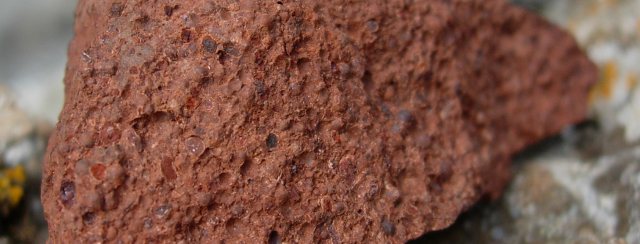Aluminium is a very useful metal; it is the most widely used non-ferrous* metal in the world. It has a very low electrical resistance and a very good strength-to-weight ratio and has therefore found many applications: from packaging in drinks cans and foil wrapping to aeroplane parts and power lines.
Luckily, aluminium is very common, making up about 8% by mass of the Earth’s crust (only silicon and oxygen are more abundant). Unfortunately aluminium is also very reactive so is never found in isolation like gold and silver are, but rather as a compound in one of 270 different minerals.

Aluminium is usually produced by extracted from bauxite, an ore made from a mixture of aluminium hydroxide, iron oxide, titanium dioxide and kaolinite.† Because it is so reactive aluminium cannot be extracted economically using chemical processes; instead it is extracted by electrolysis in the Hall-Héroult process.
 A bank of Hall-Héroult cells
A bank of Hall-Héroult cells
The Hall-Héroult process uses a huge amount of electricity; hundreds of thousands of amperes are used in each cell and a single plant may contain hundreds of cells connected in series. According to Alcoa, the world’s largest producer of aluminium, the best smelters use about 13 kilowatt hours (46.8 megajoules) of electrical energy to produce one kilogram of aluminium; the worldwide average is closer to 15 kWh/kg (54 MJ/kg).
Worldwide production of aluminium in 2010 was 41.4 million tonnes. Using the figures above this means that 621 billion kilowatt hours of electrical energy were used in the production of aluminium. To put that in perspective, the total world production of electrical energy was 20261 billion kilowatt hours, meaning that more than 3% of the world’s entire electrical supply went to extraction of aluminium.

During the same period Australia, one of the world’s largest producers of aluminium‡, produced about two million tonnes of aluminium and 250 billion kilowatt hours of electrical energy; this means that more than 12% of its electrical supply was used to extract aluminium.

The output of the Kárahnjúkar Hydroelectric Plant in Iceland is devoted entirely to the Fjardaál aluminium smelter. There has been a great deal of conflict about the environmental impact that the building of this dam has created. (via @declanfleming.)
* The ferrous metals are those that contain iron; steel is the most common ferrous metal.
† Bauxite contains aluminium in gibbsite, boehmite and diaspore; iron in goethite and haematite; aluminium and silicon in kaolinite; and titanium in anatase.
‡ Australia is the world’s fourth largest aluminium producer and the largest producer, by a very substantial margin, of both aluminium oxide and raw bauxite; the red colour of Australia’s deserts comes in a large part from the presence of bauxite.
Beautiful explination
You can see the list that profiles the world’s ten biggest power companies of 2014 based on Forbes calculation of net market capitalisation, assets, sales and profit. New list shall be published in 2015.
This article was very helpful for my biology project thank you!
I agree with you. Aluminum is used in wide range of applications for home as well as for industrial purpose. Luckily, aluminium is found easily that makes up about 8% by mass of the Earth’s crust. Thanks for sharing your very blog. Keep updating your blog and thanks for sharing
Very useful article. I’m currently undergoing research as to the resources required to produce one ton of aluminum (bauxite, gas, water, oil…). Would you know how I could have access to this information?
Thanks in advance!
What’s the big deal with electricity, bauxite, and smeltering? I get my aluminum from Schlitz Malt Liquor 40oz cans when I go to the Brew-Thru!
what,s the big deal indeed with aliminum ???
I get my xxxx in a box of 24.. drink the beer, and throw away the alu cans
That Icelandic smelter has elicited a fair bit of condemnation from eco warriors. Here’s the thing, Iceland has abundant hydro electricity, and it’s potential is much greater than any likely consumption. It’s population is tiny, moreover it’s industrial base even smaller, due to it’s isolation. Basically, were it not for the aluminum plant, there would be no hydro plant either. If, however, Iceland had fossil fuel powered plants in addition to the hydroelectric, like most countries, then the grid would have to compensate for loss of electricity to aluminium production and ramp up Fossil Fuel plant output.
This is basically the situation we have in Scotland, we have one aluminium smelter, powered by onsite hydro. The operator of this plant might claim it has zero carbon, however were it not for the smelter, that hydro electricity would go to the grid, and therefore less carbon would be emitted as FF power would be cut back.
There is the possibility that aluminium could be produced in an effectively zero carbon manner, if there are enough areas of the world with “stranded” hydroelectric, such as Iceland.
Some other facts about aluminium:
the least efficient smelters may use as much as 20kWh/kg Al – relying on very cheap coal fired power in China, which dominates world smelting capacity, and although China does now have some modern smelters and the Three Gorges hydro electric plant and a number of nuclear stations, two thirds of it electricity comes from coal, and 70% from fossil fuels, with under 9% from renewables.
Inefficient smelters consume more carbon anodes, which create added CO2, in addition to that which comes from the basic reaction 2Al2O3 + 3C -> 4Al + 3CO2. They also tend to produce (and fail to control) much higher levels of PFCs that have 6,000-9,000 times the global warming potential of CO2.
There’s also quite a bit of energy use in the Bayer process (14.5GJ/tonne quoted below, equal to 4MWh/tonne, 4kWh/kg, but mostly as heat) that reduces bauxite to aluminium oxide:
http://bauxite.world-aluminium.org/refining/energy-efficiency/
Greta T meeting Carolyn Lucas and Jeremey Corbyn (UK) and her red aluminum water bottle
Many google hits.
What an articulate and sensible comment, Phil. Keep up the good work!